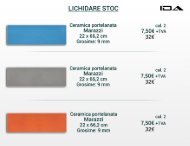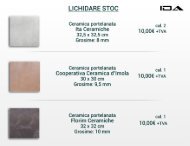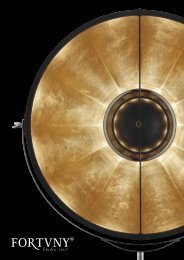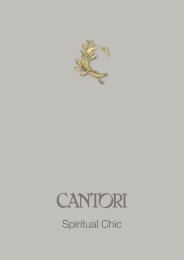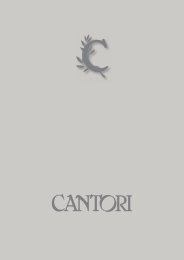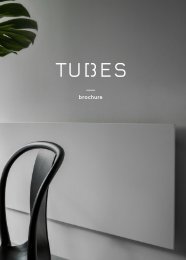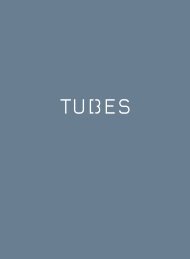Graniti Fiandre - Manualul Inginerului
Create successful ePaper yourself
Turn your PDF publications into a flip-book with our unique Google optimized e-Paper software.
FUNCTIONAL LAYERS<br />
DIE EINZELNEN SCHICHTEN<br />
COUCHES FONCTIONELLES<br />
A TOP SURFACE<br />
1. porcelain stoneware slabs: these make up the top layer<br />
of the surface to be walked on and are the main part of the<br />
system. They are the part that is on show and are subject<br />
to considerable stress. This is why it is important to consider<br />
the intended use of the floor and the type of room when<br />
choosing the finish as well as the intended look of the floor.<br />
Porcelain stoneware combines quality appearance with<br />
excellent physical and mechanical properties.<br />
2. Slab border: this has three functions:<br />
_to form an even joint between the various panels and<br />
between the slabs fitted on the panel itself;<br />
_to provide better panel-to-panel adherence and contact;<br />
_to reduce stress and strain between the slabs and to absorb<br />
any thermal expansion.<br />
A OBERBELAG<br />
1. Feinsteinzeugplatten: Sie bilden die oberste Schicht<br />
der Trittfläche und bilden den Hauptbestandteil des Systems;<br />
sie sind direkt sichtbar und sind den Beanspruchungen<br />
ausgesetzt. Aus diesem Grund ist es erforderlich, bei der<br />
Auswahl der Oberfläche, außer der Ästhetik die<br />
Raumeigenschaften und den Verwendungszweck der Räume<br />
zu berücksichtigen. Feinsteinzeug vereint Ästhetik und<br />
hervorragende physikalisch-mechanische Eigenschaften.<br />
2. Seitliche Kante der Platte: Sie besitzt drei Funktionen:<br />
_Homogener Fugenverlauf zwischen den verschiedenen<br />
Tafeln und zwischen den auf derselben Tafel montierten<br />
Platten;<br />
_Ermöglichung einer besseren Haftung und eines stärkeren<br />
Kontakts zwischen den einzelnen Tafeln;<br />
_Dämpfung der Erschütterungen zwischen den verschiedenen<br />
Platten und Ausgleich eventueller Wärmeausdehnungen.<br />
A FINITION SUPÉRIEURE<br />
1. Les dalles en grès cérame : constituent la partie supérieure<br />
du plan de piétinement ainsi que le composant principal du<br />
système. Il s'agit de la partie directement visible et sujette aux<br />
contraintes. Pour cette raison, le choix de la finition superficielle<br />
doit tenir compte, non seulement des caractéristiques esthétiques,<br />
mais également des caractéristiques de l'espace et du type<br />
d'utilisation.Le grès cérame allie des qualités esthétiques et des<br />
caractéristiques physiques et mécaniques exceptionnelles.<br />
2. Bordure de la dalle : elle a une triple fonction:<br />
_concevoir de manière homogène les joints entre les divers<br />
panneaux ainsi qu’entre les dalles posées sur un même panneau;<br />
_permettre une meilleure adhésion et un meilleur contact entre<br />
les panneaux ;<br />
_atténuer les contraintes entre les différentes dalles et<br />
absorber les dilatations thermiques éventuelles.<br />
B PANEL<br />
3. support: this is the structural part of the top surface<br />
and supports the load transmitted by the porcelain<br />
stoneware slabs, distributing it to the structure underneath.<br />
It can be made of various materials offering different<br />
values of mechanical and fire resistance, which should be<br />
taken into consideration when assessing the project’s<br />
requirements.<br />
4. perimeter: this is designed to facilitate the assembly<br />
of the panels when the floor is being fitted. It both protects<br />
the sides of the panel and represents a contact point for<br />
the transmission of the horizontal strain between the<br />
panels.<br />
5. bottom surface: this protects the panel against moisture<br />
and can be designed to enhance its mechanical<br />
performance.<br />
B TAFEL<br />
3. Träger: Er ist der tragende Bestandteil der Trittfläche,<br />
trägt die von den Feinsteinzeugplatten aufgenommenen<br />
Lasten und überträgt sie an die darunter liegende Struktur.<br />
Hier stehen Materialien mit unterschiedlichen mechanischen<br />
Festigkeits- und Brenneigenschaften zur Verfügung, die<br />
entsprechend den Erfordernissen des Projekts ausgewählt<br />
werden müssen.<br />
4. Umlaufender Kantenschutz: Er ist so konzipiert, dass<br />
das Zusammensetzen der Tafeln beim Verlegen vereinfacht<br />
wird und besitzt außerdem sowohl die Funktion eines<br />
seitlichen Schutzes für die Tafel als die der Bestimmung<br />
eines der Kontakt- und Belastungspunkte bei horizontaler<br />
Beanspruchung zwischen den Tafeln.<br />
5. Unterbelag: seine Funktion ist der Schutz der Tafel vor<br />
Feuchtigkeit und ggf. die Verbesserung der mechanischen<br />
Eigenschaften.<br />
B PANNEAU<br />
3. support : il s'agit de l'élément structurel du plan de<br />
piétinement qui supporte les charges transmises par les dalles<br />
en grès cérame et les distribue à la structure sous-jacente. Il<br />
est constitué de matériaux de différentes caractéristiques en<br />
termes de résistance mécanique et de résistance au feu,<br />
caractéristiques qui doivent être établies en fonction des exigences<br />
du projet ;<br />
4. bord du périmètre : il est conçu de façon à faciliter<br />
l'assemblage des panneaux lors de la pose. Il assure une fonction<br />
de protection latérale du panneau et détermine un des points<br />
de contact et de transmission des contraintes horizontales entre<br />
les panneaux ;<br />
5. finition inférieure : sa fonction est de protéger le panneau<br />
de l'humidité et, au besoin, d'améliorer ses performances<br />
mécaniques.<br />
C STRUCTURE<br />
6. gaskets : to safeguard the stability of the link between<br />
the structure and the panel and increase the continuity of<br />
support.<br />
7. cross-section stringer: connects the columns horizontally<br />
in order to achieve the required modularity, improving<br />
stability and the distribution of loads across the structure.<br />
8. column: to support the panels and transmit the load to<br />
the concrete slab. Micrometric adjustment is used to<br />
determine the correct height of the raised floor and<br />
compensate for any irregularities in the surface they rest<br />
on.<br />
C STRUKTUR<br />
6. Dichtungen: Sie gewährleisten eine stabile Verbindung<br />
zwischen Struktur und Tafel und erhöhen die Kontinuität<br />
der Auflage.<br />
7. Querstrebe: Sie verbindet die Ständer horizontal<br />
miteinander, um die erforderliche Modularität herzustellen<br />
und dabei die Stabilität und die Verteilung der Lasten auf<br />
der Struktur zu verbessern.<br />
8. Ständer: Er hat eine Stützfunktion für die Tafeln und<br />
überträgt die Lasten an den Estrich. Die Mikrometer-Einstellung<br />
ermöglicht die genaue Bestimmung der Höhe der Doppelböden<br />
und die Kompensierung einer nicht planen Auflagefläche.<br />
C STRUCTURE<br />
6. garnitures : assurent la stabilité de l’assemblage entre<br />
structure et panneau, en assurant la continuité de l'appui.<br />
7. chevêtre : assure la jonction horizontale des colonnes afin<br />
d’obtenir la modularité nécessaire et de renforcer la stabilité et<br />
la répartition des charges sur la structure.<br />
8. colonne : soutient les panneaux et transmet les charges à<br />
la chape. Le réglage micrométrique permet d'obtenir la bonne<br />
hauteur du sol surélevé et de compenser les défauts de planéité<br />
du plan d'appui.<br />
127



